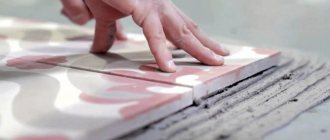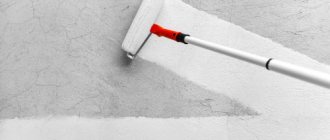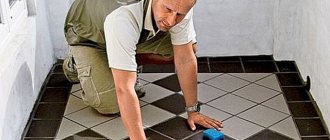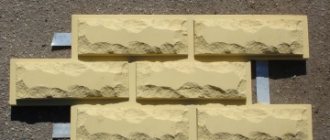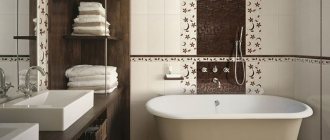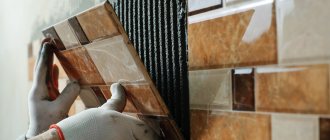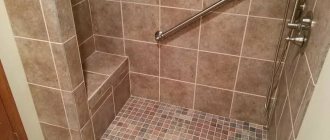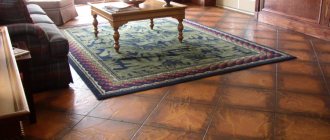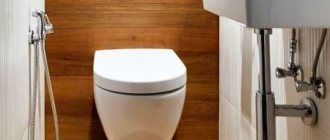When finishing walls, corners for tiles in the bathroom solve the problem of masking the uneven edge of cut tiles. In a standard separate bathroom there are 4 internal corners of the walls, one junction of the side of the bath, joints between the vertical enclosing structures, the ceiling and the floor.
External corners appear on gypsum board frames, doorway slopes, and homemade architectural elements. Metal, PVC, ceramic profiles allow you to hide the untreated end of the tile and improve the quality of the interior.
There are options for decorating corners on walls with tiles without a special profile. For example, professional tilers do not work with corners, preferring to “bevel” - trimming or grinding the ends at outer corners at 45°.
Peculiarities
Decorative corners are used during the final stage of renovation.
The main purposes of the corners:
- give the finishing touch to the decorative design;
- neat and stylish design of the joints between tiles and plumbing fixtures, especially when it comes to difficult areas of the room;
- Use during refinishing or upon completion of renovations.
Depending on the shape, experts distinguish two types of corners.
- External. Use to design a convex corner. The main purpose is wall decoration. Thanks to them, sharp parts can be covered simply and practically.
- Internal. They are chosen when you need to design a concave (internal) corner. If you need to level the surface between the tiles and the bathtub or create a corner, choose corners of this type.
From a design point of view, corners can be divided into two groups:
- Decorative. During the manufacturing process of these elements, special attention is paid to the appearance of the product. They can have different colors and shapes depending on the style. The material most often used for manufacturing is ceramics or PVC.
- Functional. This is the main group of corners presented on the modern market. They are characterized by increased reliability, stability and practicality.
Where will corners be needed?
Trimming tiles is inevitable when decorating walls with this facing material for a number of reasons:
- the most aesthetic option for laying out tiles is “from the middle”, the tiles are cut in both corners;
On the boxes, all tiles are cut to obtain a beautiful layout without narrow and asymmetrical pieces. - the edge of the cut is very rarely perfectly smooth, the glaze may chip;
- If the finisher is not sufficiently qualified, the tiles may turn out shorter than the required size.
Therefore, you have to seal the joint with grout or initially use a special profile that allows you to hide minor defects. A corner seam occurs at the junctions of the following surfaces:
- wall/wall – internal vertical;
- wall/ceiling – internal horizontal;
- wall/floor – horizontal internal;
- wall/bath – internal horizontal;
- wall/wall – vertical external;
- wall/slope – external vertical and horizontal.
Important: In a separate bathroom with brick walls, the last two options are rare, since communications, metering devices, shut-off valves are often located near the toilet, that is, the boxes are built inside the toilets.
The joint between the bathtub and the wall needs not only finishing, but also sealing against leaks.
Installation technology
Aluminum, plastic and metal trims are attached to the wall surface using tile adhesive. The profiles have a perforated inner surface, which allows them to be slightly pressed into the adhesive layer for better fixation.
Layouts are divided into 3 groups: hard, semi-rigid, soft. To design corners and joints of complex geometry, the best option in choosing profiles would be plastic layouts, since they are easy to cut. Straight and clear joints cover metal products well.
Installation of corners for external joints:
- Make markings on the wall. To do this, cut off the required length of the profile and apply it to the finished joint. Rectangular tiles or products of a different configuration are inserted into the trim groove on both sides. Measurements are taken and the necessary marks are marked on the wall.
- The corner is covered with glue and the elements are laid. The correct installation is controlled by the marks made at the beginning.
- The edges of the tiles are inserted into the grooves and the trim is pressed against the surface of the cladding to remove voids.
- Remains of glue are removed with a rag, and the surface of the cladding is wiped dry.
To prevent the tile from “floating”, it is additionally fixed with masking tape, which is removed after the glue has dried.
The decorative corner for internal joints consists of several parts:
- groove for tiles;
- perforated protrusion;
- concave fragment.
Installation begins after the facing material has been completely laid on the wall. The profile is chosen 2-3 mm larger than the thickness of the tile. Apply glue to the cladding. The elements are applied to the edge of the wall covered with adhesive material, pressing tightly. Place the tile into the groove. The same procedure is done on the other side of the corner. Press firmly to remove voids between the tiles and the trim. After drying, grout the joints.
Particular attention should be paid to the processing of joints. When installing the layout between the edge of the bathtub and the adjacent wall, you need to treat all the cracks with sealant so that there are no large gaps left
This very important procedure is performed using an aquarium protective coating. Laying of trims begins after the glue has completely dried. The use of a PVC profile to seal the joint between the bathtub and the wall is most justified. It cuts well, does not allow moisture to pass through, and quickly sticks to “liquid nails” or tile adhesive. When gluing, the corner is pressed tightly against the wall and the edge of the bathtub.
Pruning
When cutting layouts, it is necessary to take into account the characteristics of the material. Cutting is done with a hacksaw or grinder. When using a hacksaw, you can use a miter box. This carpentry tool is essential for cutting corners correctly.
Advantages and disadvantages
Before using the above items, you need to familiarize yourself with the advantages and disadvantages of this product.
Pros:
- due to reliable adhesion at the corners, the strength of the walls increases;
- the work of installing tiles becomes easier due to the absence of the need to trim the material;
- decorative design acquires accuracy and sophistication;
- increased level of safety - additional elements cover sharp parts that can cause injury;
- protection against mold and mildew in tile joints;
- the level of tile resistance to moisture increases;
- In the process of cutting tiles, the percentage of chipping decreases.
Due to the above advantages, structural elements are the best option for renovation work in the bathroom. They have a positive effect on the appearance of the room, facilitate the work process and improve the performance of the finishing material.
The parts also have certain disadvantages.
They are related to the materials used in manufacturing and some other aspects:
- After a certain time, corners made of white plastic begin to lose their former whiteness, acquiring a yellow tint. Designers recommend using colored or dark elements whenever possible.
- If a small gap is formed during the installation of a plastic profile, moisture will accumulate in it.
- Installation of ceramic products is difficult. During the process, you must be as careful as possible so as not to damage the product.
- To ensure that chrome corners retain their shine and shine for a long time, do not install them on a surface that you will touch frequently.
- Perfect evenness is necessary when installing metal corners, since it will be impossible to correct this later.
Docking methods
There are several methods for finishing wall corners. In this article, we suggest you consider the following options:
- Direct docking.
- Edge trimming.
- Using trims.
- Corner tiles.
Each of these methods has its own differences. We are confident that one of the listed methods will help you lay tiles.
Direct docking
You can lay tiles at right angles. This is the easiest way without any hassles. That is, it is assumed that the tiles are joined to each other without any trimming. As a result, one slice will be hidden, and the second in plain sight.
This method allows you to level a corner in any part of the wall, even the most inaccessible, with the least effort. If the tiles converge into a corner and one of the edges is cut off, then think about it so that it is not visible. It is better to have a factory cut on the outside.
Another method that involves perpendicular joining can also be included in this category of joining tiles. This method is only relevant if a special border is used to cover the protrusions.
The principle of joining tiles is as follows: the tile is glued to the surface so that the top tile, located horizontally, hangs over the edge. In this case, the joint of the tiles in the corner will be neat (provided that the canopy reaches no more than 5 mm). In this case, it is important that the overhanging edge has a factory cut.
Laying tiles in an internal corner - video
Edge Trimming
We can safely say that this is the most difficult way to decorate the corners of ceramic tiles. It is mainly used by those who have special equipment for cutting tiles or by experienced tilers.
The idea is that the sides of two tiles are cut at 45°. The result is a perfect 90° angle. Mostly the tiles are placed so that there is a small gap near the walls. A tile at least half the width of the whole is placed in it.
And laying it is not difficult, because it has a rectangular shape. To form such a clear angle, you need to understand that the walls must be perfectly aligned. If the angle of the wall, both internal and external, does not have 90°, then cutting 45° corners on the tiles does not make sense.
As for the cut, it is best done with an electric tile cutter. The cutting element should be a diamond-coated circle. Due to high speeds, a perfectly even and smooth cut is obtained.
The only thing is that the guide on the bed must first be set at 45°. After such a cut, you will not need to further process this side of the tile.
Some craftsmen have adapted to using a budget option, making the cut with a regular tile cutter and adjusting the edge with a grinding machine. However, this method has its drawbacks. It is extremely difficult to make a perfect cut, as is the case with an electric tile cutter.
If you already have a tile cutter, and it has the ability to change the cutting angle, then you can beautifully design the internal and external corners of the walls.
A visual example of tiling a corner with cutting tiles at 45 degrees
Using Trims
This decoration of wall corners is in great demand. Joining tiles using trims greatly simplifies the tiling process. They exist both internal and external.
One of the main advantages is that it is possible to choose trim of a wide variety of colors, which will be most suitable for decorating a corner. They can be plastic or metal. Accordingly, they differ in cost, the first ones are much cheaper. Among workers, trims are also called corners.
So, to finish the outer corner, an L-shaped corner is used. It has a slight bulge. Corners for internal corners have a concave shape. They are often used as a transition from tiles to a bathtub.
The advantages of such corners:
- Excellent aesthetic properties.
- Excellent protection of corners from possible mechanical damage. If you accidentally catch a corner with a heavy object, you will have to replace not the tile, but just the corner. And if the corner is metal, then no damage will be visible at all, except perhaps a small scratch.
- Trims are convenient for finishing wall corners. There should be no difficulties during laying the tiles.
- When forming a tile corner, there is no need to use expensive equipment, such as a tile cutter. It is enough to have a level at hand.
- The trim is glued using liquid nails or silicone. Special adhesives can also be used. Some specialists can lay such corners on the same mortar that is used to lay the tiles.
Options for correct installation of tiles on external and internal corners - video
Corner tiles
Ordinary corner tiles are often used to decorate wall corners. But not all manufacturers produce tiles of this shape. By far, this is the easiest way to trim corners. In appearance, they are presented as two tiles connected at 90°.
However, they are used primarily for external corners. When laying tiles of this shape, glue is used, onto which the remaining tiles are laid in a straight line.
The result is beautiful. Using special corners made of metal or plastic cannot even compare with this method.
Materials
Manufacturing companies use various materials to produce corners. Each of them has its own performance characteristics.
Metal
Designers call aluminum products the optimal choice for most stylistic trends. Lightweight and durable metal harmonizes perfectly with sanitary ware, bathroom furniture and a wide color palette. Elements of this type are ideal for working with outdoor tiles.
In terms of strength and hardness, the leading positions are occupied by corners made of stainless material. Due to its special properties, it is ideal for use in rooms with high humidity. As a rule, they are made in gold or silver. Often there are options plated with brass, chrome and nickel.
Chrome elements are an ideal choice for high-tech style.
PVC (plastic)
The products are lightweight and particularly flexible. Manufactured in a variety of colors. Can be used at any stage of gluing. In terms of price, this is the most profitable option, and therefore widespread.
Ceramics
Ceramic models attract attention with their expressive appearance. They stand out from the rest with their decorativeness, patterns and expressiveness. If tiles were used to decorate the bathroom, ceramic corners are ideal.
Design nuances
Considering the subtleties of interior design with tiles, you can avoid annoying mistakes:
- If the choice fell on wall ceramics with a vertical pattern for a small bathroom, the room with such decoration may seem narrow and high, like a well;
- Not worth it for a room with an area of less than 10 square meters. m. buy tiles with a large and bright pattern;
- Likewise, a panel on the entire wall does not look good in a small bathroom;
- A glossy surface tends to reflect light and create glare. Such illumination has a tiring effect on vision;
- The established design of the top of the wall with light tiles and the bottom with dark tiles evokes boredom. Separate dark, horizontal or vertical stripes on a light background will help to move away from the classical tradition.
Selecting ceramic tiles according to the rules will allow you to find a bathroom that will be distinguished by its excellent design and convenient operation of all elements.
How to lay tiles in corners: basic rules
There are several options for connecting tiles:
- Perpendicular connection. The simplest way to solve the problem is a direct connection. In this case, the tiles are laid at 90 degrees, that is, one cut remains open, and the second is disguised under the top element. This way you can close any corner with minimal effort. If tile trimming is required, it is best to install the cut from below. The disadvantage of this method is the seam when connecting. Subsequently, it is masked with grout, but it is still visible on the surface.
- Trims. The most popular option is probably the installation of special elements - trims. This is a plastic profile that forms the necessary direction. For external corners, an L-shaped installation is used. The internal corner has the shape of an arc. Sometimes narrow convex trims are used.
- Pruning. This method is based on trimming the edge of the slab. It is performed in such a way that the fragments can be connected to each other at 45 degrees.
Perpendicular arrangement
The simplest solution to the issue is direct docking. In this case, the elements are laid perpendicular to each other, that is, so that one cut remains visible, and the other is hidden under the upper fragment.
In this case, a corner in any part of the walls is closed with minimal effort. If adjustment of the tile is necessary, it is advisable to place the cut edge under the bottom. The disadvantage of this method is the presence of a seam at the junction. Later it is sealed with grout, but this still affects the appearance of the surface.
Options for laying tiles at internal joints
There is another way to join tiles perpendicularly in the corners. This method is suitable, for example, for finishing curbs or bathroom frames. The main condition is that the cladding should not be visible from below.
The essence of the method is as follows: it is necessary to glue the tile so that the horizontally located (top) tile hangs over the edge. The corner will turn out neat if the width of the canopy is within 3-5 mm. The only condition is that the edge must be solid.
Edge Trimming
For more accurate work you will need special equipment. The method is based on cutting the edge of the tile at 45 degrees. The task is performed in the following ways:
- grind the edge with a grinder;
- a tile cutter is used;
- sandpaper is used.
The best option is to process tiles with an electric tile cutter with an inclined bed.
How to lay such wall tiles? For this purpose, the tiles are cut and glued with mortar into the corner so that their edges coincide and form a solid covering.
One way to lay tiles in internal and external corners is to trim the chamfer at 45 degrees.
For beginners, laying tiles in the bathroom using this method is not easy. If possible, practice on unnecessary material. Please ensure that the surface of the walls is as smooth as possible, otherwise you will need to lay a layer of glue of different thicknesses on it, which will disrupt the position of adjacent elements.
Using Trims
These are special inserts. The method using them is the most popular. They are a plastic profile that forms the angle of the desired direction. An L-shaped pad is used for external projections. And the inner surface has the appearance of a concave arc. Narrow convex models are also used.
One more important issue needs to be resolved - how to glue the plastic corner to the tile. Several options are possible:
- sealant;
- glue;
- liquid Nails.
Often, such trims have a special design that allows them to be laid on the solution. A special plate is driven under the tile and fixed with tile adhesive. This installation is extremely simple, the surface acquires a neat appearance, and the joints are protected from moisture and bacteria.
Some options for cladding inserts
The external plastic corner and trims at the junctions with the plumbing (curbs) are fixed differently, for example, using silicone or acrylic sealant. How exactly to glue the plastic to the tiles in the bathroom does not make much of a difference. This type of finishing of walls or corners of the box is suitable for almost any type of material.
Elimination of defects
It is not always possible to connect elements correctly and flawlessly, especially for beginners. Nevertheless, it is possible to remove some shortcomings. If you cannot lay a corner with ceramic tiles evenly, try to compensate for the flaws with mortar, for example, by raising the adjacent element to the desired level.
When pruning, it is not always possible to achieve a slope of exactly 45 degrees. If not enough material is cut, the excess can be easily sanded down until you have a smooth angle.
Another point is the presence of defects at the junction. There are two options to fix the problem:
- The first is that installation is carried out in the prescribed manner, and chips and gaps are covered with grout during the finishing process.
- The second option is that after the mortar and fugue have dried, a plastic profile (decorative corners for tiles) is glued to the corner, masking these wall defects. Its installation is done using silicone or liquid nails.
Finishing corners is not an easy job, but it can be done if you correctly follow the tips presented above.
Preparatory activities
Before tiling a corner, you should think about carefully preparing the walls and floor themselves.
- They are pre-aligned so that the material does not peel off over a short period of time.
- Another possible defect in laying ceramic tiles on an uneven base is a poorly executed external or internal corner.
- In addition, the surface at the time of work must be not only dry, but also clean.
- It is important to check the horizontality of the floor and the verticality of the walls. This is done after the old coating has been removed.
- If we are talking about walls, then a plumb line is used in the form of a selected type of load attached to a thread.
A large number of tools can be used to measure angles:
- For horizontality, a building or water level is used. Everything will depend on the preferences of the performer.
- There is also a laser level, but its cost is very high for use in one-time work.
If these works are not completed before laying the tiles, subsequently gaps will form in the corners, spoiling the whole picture.
A layer of waterproofing in the form of a coating mastic is first applied to the cleaned surface, followed by a primer. If there are even minor defects, they should initially be repaired with putty. To create a flat surface, pour the following onto the base of the floor:
- cement-sand screed;
- self-leveling mixture.
We must also not forget about waterproofing and a primer layer.
Tile leveling systems will help you carry out tiling work with the highest quality possible!
Our online store invites you to buy new innovative tools presented on the Russian market, which allow you to lay tiles with the highest quality possible. Our assortment includes three varieties of the most popular leveling systems - DLS, SVP and Litolevel. All of them have excellent factory quality, leave production with a complete absence of defects, and are made of impact-resistant plastic. It is impossible to say for sure from which category of people they have gained the greatest popularity. Beginners who have used leveling systems speak highly of them, as they helped them lay tiles with high quality without experience. Professional masons value working with leveling systems , as they significantly simplify facing work and, in addition, allow the work to be done several times faster. Thus, they manage to complete several norms during a working day and, accordingly, earn more. In addition to leveling systems , we also sell 3D crosses, which are also popular among layers. If we compare systems and crosses, the former are more universal and allow, in addition to obtaining even seams, to organize a perfectly flat surface, thereby solving two problems. The cost of leveling systems is slightly higher, but they are more functional.
Tools and materials
In the process of finishing the walls and floors indoors with tiles, the material itself will not be enough. You will also need the following list:
- Special glue (if you are laying tiles in corners in rooms with high humidity, such as a bathroom, purchase water-repellent glue).
- Spatula with teeth.
- Crosses that allow the tile elements to be joined together correctly and evenly. Their thickness is selected individually, taking into account the created distance.
- Profiles for finishing (for example, plastic or ceramic corner).
- A building level for even distribution of tiles on the surface, as well as a tile cutter necessary to create even corners, both external and internal.
It is important at this stage to find out the exact number of tiles required for the job. In this case, the tile seam between the elements is taken into account, which is usually 3-5 mm, and the “red” place (in plain sight) is determined, to which increased demands are placed due to constant attention from the entrance.
Ceramic borders
It was quite difficult and diligent work: I had to cut small squares from the tiles, which were then used to form the slope from the wall to the bathtub. If the work was done conscientiously, the effect was absolutely decent. Now there is no such need.
In many construction stores, when you buy tiles for a toilet, they can immediately recommend favorable ceramic borders. But often they still have to be purchased separately. When choosing such a frame, you need to work hard so that the border matches the color of the tile itself.
In exceptional cases, you should choose a white border, then merging with the plumbing fixtures, it will not stand out from the uniform design.
Making an internal corner
If you need to work with corners on the walls, then everything should start from the “red” place. There are several nuances:
- The tiles should be laid on adjacent sides and strictly symmetrically.
- If tile scraps are used, they must be identical in size and parameters.
- When a special tile cutter is used, it already has such a function as determining the exact distance for cutting tiles. If you don’t have a tool, you’ll have to calculate everything yourself.
Stages of work
- Work begins from the floor in the room. Initially, the selected adhesive option is applied to the wall, occupying approximately 1 square meter. A special spatula will allow you to distribute it evenly over the entire surface.
- One tile after another is glued.
- You can achieve an even seam in various ways, one of which is by inserting special crosses.
- When the first row is ready, it should be checked using a building level. In this case, when joining with the opposite wall, the tile is cut to the required length, after which it is attached to the wall.
Ways to create an internal corner
When you begin laying tiles on an adjacent wall, you can use the remainder of the tiles from the first row. It will be more problematic to choose the right drawing. The main thing is to combine them with each other, not forgetting about the tile seam at the joint. If there remains a gap of 2 mm after laying the tiles overlapping, we will get a feeling of curvature. Maintains attractiveness and appearance.
Down with the old coating!
Regardless of whether it is planned to glue the tiles without preliminary preparation, or a decision is made to level the walls with a layer of plaster, it is necessary to remove all the old coating, be it enamel, whitewash, wallpaper or old tiles. If it turns out that the layer of old plaster under these coatings is crumbling or coming away from the brick in layers, then the plaster will also have to be brought down to the ground. The work is not pleasant, but you can’t do without it. Enamel and whitewash are difficult to remove, so you can leave them, but you should make frequent notches on the wall. Notching the walls can be done with any handy tool convenient for this: a grinder, the pointed end of a hammer, or even an old ax.
Differences between external and internal corners
When carrying out work, remember the difference between internal and external elements. The first option is the space where the surfaces of two walls meet along the perimeter of a standard room. The second is a protruding area.
The most striking difference is demonstrated when installing plastic corners for tiles. Trims have fundamental differences from each other, depending on their purpose for a particular area.
Examples of designing corners using trims
Also keep in mind that it is easier to glue the internal trim tiles, because in case of deviation from the norms, the situation is corrected with the help of glue and grout. In general, the fugue looks more organic on the inner corners of the walls. In the bathroom this is of particular importance, because external projections, for example, when installing a box, are more susceptible to destruction. Over time, the fugue simply crumbles and is washed out from there. That is why it is better to lay an additional plastic corner on the tile, which will not only protect, but also decorate the surface.
Taking into account the size of the bathroom
When choosing material and layout, adhere to the following rules:
- In a small room, medium-sized tiles, for example, 15x15 or 20x20 cm, are appropriate. Large ones here will emphasize the lack of space, and mosaics will have the same effect - due to the abundance of seams.
- In a spacious bathroom, both small and large tiles look harmonious.
- For a compact room, glossy tiles are preferable - they visually make it more spacious. In a large bathroom, you can install matte cladding: unlike gloss, it does not show drops, stains after wet cleaning, or finger marks.
- When decorating small rooms, avoid dark colors. Light ones are needed here - they create the illusion of space. The same effect is achieved through a smooth transition from dark shades below to light shades above.
- In a larger bathroom, colors are used more freely. Sharp transitions and bright, rich colors are appropriate here.
- In the decoration of small rooms, the presence of a large number of decorative elements is undesirable: all the objects here are located close to each other, so the interior will be overloaded.
- laying tiles in cool colors: gray-turquoise, silver, blue;
- formation of a horizontal pattern on the walls;
- diagonal laying of floor tiles;
- border in contrasting color, friezes near the floor and ceiling.
The following techniques visually add height to the ceiling:
- vertical laying or pattern;
- vertical friezes;
- highlighting corners with color;
- placing decorative elements at eye level or higher.
Other corner design options
Installing a profile is an optional condition for upgrading the ribs between enclosing structures lined with tiles or mosaics. You can perform the same operations correctly in several ways:
- grind the edges of the cladding at 45 degrees;
- lean the tiles overlapping each other;
- Leave space between the tiles for grouting.
The most difficult is the corner on a short box, a podium, formed by three planes at once - two vertical walls, one horizontal plane.
Universal trims: internal and external corners when laying tiles
If we take as a basis not cheapness, but indeed ease of installation, it makes sense to pay attention to laying tiles in the internal corners, as well as in the external ones, using trims. These are a kind of functional profiles of a special shape, which are most often made of plastic, but can also be aluminum or even brass. For external corner joints they have a U or L-like shape, and for internal corner joints they often have the appearance of a concave arc. There are also a variety of convex trims, but they are used less frequently.
These trim profiles will easily help solve such a complex issue as how to lay tiles if the corners are uneven, because these defects must be hidden from view. To glue the trim, you can use liquid nails, sealant, as well as the usual tile adhesive that you used to lay it, but only if we are not talking about cement compounds.
There are also complex trim designs for which installation with cement or cement-based adhesive is truly acceptable. Such trims are attached immediately to the mortar, since their edge is driven under the tile, where it is finally fixed. This is a fairly basic process that even a beginner can complete. At the same time, trims reliably protect the seams from moisture entering them, therefore, preventing the proliferation of bacteria, as well as the growth of mold and fungi.
Overlapping method
The perpendicular joining method is used for right external/internal corners. The end of one tile is located at a 90 degree angle to the other, flush.
The same seam is left between the tiles as in the adjacent rows. The joint is positioned in such a way that the solid tile masks it when viewing the room from the doorway, as in the photo below.
Cutting tiles at an angle
Another very popular method for making corners when laying tiles is cutting them at an angle of forty-five degrees, then you get a beautiful joint, but you can’t do this without special equipment.
The most affordable method for grinding tiles at an angle is to use a professional electric tile cutter, which allows you to turn the cutting diamond wheel at the desired angle. However, such an instrument is quite expensive, so not everyone can afford it. How to cut tiles at an angle without a tile cutter is worth reading the article on our website, where everything is written out and laid out on shelves for ease of understanding.
It is worth understanding that for a beginner this installation method may be overwhelming, since there are many nuances and subtleties that will have to be observed. It is very important that the tiles match perfectly, otherwise a harmonious appearance will hardly be achieved. If the corners themselves are not even enough, you will have to level them using tile adhesive, which without much experience “by eye” will definitely not work the first time.
Burying method
The method is used only for external corners, called the “Kremlin corner”, bevelling, trimming, sharpening, cutting at 45 degrees. The ends of the tiles are cut at 45°, the decorative elements are joined closely to each other without seams or grouting.
You can grind off unglazed ceramics from the back of the cladding manually with a file or a whetstone. However, it is more convenient to use an angle grinder with a flexible diamond disk “Turtle” with a grain size of 50 units.
The outer corner in a combined bathroom often ends up on the edge of the inspection hatch under the tiles. In this case, instead of regular grout, use silicone sealant of a suitable color.
This material has increased plasticity, even after hardening, it does not fly off the edge of the tile.
Forming an angle at the junction of three planes
An additional element - a capsule plug for an external/internal corner - is available exclusively in collections of metal corners from domestic and foreign manufacturers.
The tiled profile itself is ideal for cladding the ribs formed by connecting walls.
Plug capsule for metal trims.
The plug is designed to fit into a vertex formed by the intersection of two or three edges. One side of the capsule is inserted inside the profile, the other two are adjacent to the remaining layout on the adjacent walls.
Wall-floor joint
To decorate the internal corner formed by porcelain stoneware flooring and tiles on the bathroom wall, the following methods are used:
- embedded profile made of polymer material, metal, ceramics;
Aluminum corner corner. - patch corner PVC, aluminum, brass;
Corner for the internal corner of the invoice. - baseboard for tiles;
Embedded plastic plinth for the bathroom. - ceramic or porcelain stoneware border.
- without a plinth - this is the most aesthetic and correct option; the joint is grouted with tile grout.
A regular PVC skirting board does not fit well with ceramic cladding, however, this is the only option with cable channels inside for electrical wiring, ensuring high maintainability of the wire.
Connecting the wall to the ceiling
The choice of layout for designing the angle of contact between the wall tiles and the ceiling depends on the method of finishing the floor slab:
- whitewashing, painting - overlay polystyrene foam fillet, glued to both surfaces;
Foam ceiling plinth in the bathroom. - PVC panel - profile made of the same material;
PVC profile. - suspended ceiling - special insert.
Connecting tiles to a suspended ceiling without a plinth.
Bathtub connection unit
The main problem with the junction of the bathtub bowl and the walls around it is to ensure tightness. The classic option is to tile the walls entirely along the entire height. There are several methods for designing the junction of the bathtub to the wall:
- sealant is a budget option, but short-lived;
Seal the seam with sealant. - border tape - heated with a hairdryer, has an adhesive layer for fixing one edge to the wall, the other to the bathtub bowl;
Border tape. - polymer plinth – F-shaped profile with a long bottom shelf, side plugs included;
Sealing the bathtub against the wall with a plastic baseboard/ - ceramic border - low manufacturability of installation due to the short length of the elements and their large number;
Upgrading the bathtub junction with a ceramic border.
The downside of all of the above options is the lack of tightness of the upper joint, plus the easy dismantling of the bath without destroying the lining. But at the same time, the most reliable technology is wall cladding from the side of the bathtub, when its bowl is partially embedded in the wall.
Laying tiles from the side of the bathtub.
The bottom row is usually trimmed to even out the lack of horizontal lines and to hide other defects. After which, you have to mask the defects of tile cutting. For this, a PVC layout is used, which has elastic properties to compensate for the linear expansion of the bath when heated.
Types of corner elements
So, to solve the problem of competently joining the coating at the corners, you can use special elements. Moreover, experienced craftsmen have become acquainted with them and use them in their work for quite a long time. They know that a tile corner is a very convenient and easy-to-use device. If we characterize such parts, then in general they can be described as elongated strips with corresponding grooves for inserting ceramic edges into them, through which the evenness of the cladding at the joints is ensured. Due to them, it is possible to partially mask defects in the material (ceramics or plastic), the possibility of which cannot be excluded when cutting off the facing elements.
Typically, the length of the corners for ceramic tiles is no more than 250 cm. These mounting elements make the cladding more concise and complete. Why does the room only benefit? The characteristics of the junction dictate their conditions for the installation of one or another type of element. For example, at an external joint, the ends of the ceramics will regularly experience mechanical stress.
To prevent this, they are strengthened. If the corners of the tiles are strengthened, the coating will better cope with the emerging loads that inevitably appear in the bathroom. The joints with the corners will be safe, and their service life will increase. Sometimes in stores you can find another name for tile corners - trims. Some manufacturers of building accessories call this tile element this way. Despite the name, the following types of corners are distinguished based on the base material:
Aluminum - will be appropriate where ceramics of 2 or 3 shades are combined in the corner area and where a color plastic trim cannot solve the task assigned to it. And all thanks to the reliability and neutrality of the color of such an element. In addition, the color of the aluminum fittings is a good complement to the metal parts in the shower stall.
Plastic - made of polyvinyl chloride profile, they have a wide range of colors. These are lightweight, flexible and waterproof elements. Due to the light weight of PVC parts, it is possible to glue them to the joint with a silicone sealant after laying the ceramic coating. When installing a shower stall, this is the most indispensable option.
Metal - these corners for bathroom tiles are made of metal, they are wear-resistant and reliable. To cope with their role as fixing elements, they must be perfectly even. Since even a slight distortion will affect the laying of the cladding. They are made from stainless metal. Such corners for laying tiles can be found in gold or silver; they often have a nickel or chrome coating on the front side.
Ceramic - they allow you to mask seams, waterproof them, and give the entire cladding an aesthetic appearance. Their distinctive feature is that they have a pattern, exactly the same as on a tile cloth. Ceramic products are not cheap and usually come in addition to one or another tile collection.
There are differences not only in materials, but also in which corner the product belongs to (internal or external). In addition, trims differ in their installation method - for horizontal or vertical installation. There are also differences in the angles for tiles in their sizes. The latter have certain designations, reflected in the numbering from 6 to 12. The digital value indicates the distance from the base of the product to its edge line. Craftsmen select trim sizes, which are always 1 mm larger than the tiles. For example, for 7 mm tiles they take trims number 8.
The solution to all problems: corner tiles
When dealing with the question of how to lay tile corners, it is worth paying attention to the tile lines that the manufacturer produces taking into account the presence of corner tiles. Then the problem is completely removed, since such ceramic corners can not only be easily laid, but will also even out uneven corners.
Many manufacturers offer a wide selection of corner tiles for both external and internal orientation. Such corners are laid out first, and the rest of the tiles are joined to them. Creating solidity and external integrity of the finish, the choice of such a design looks very harmonious, although such a finish will cost a little more, but not so significant as to refuse it.
